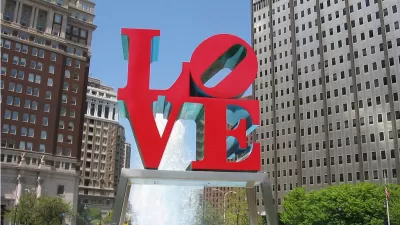As the redesign for LOVE Park begins, Ashley Hahn reminds us of the park's role in supporting and maintaining civic life in the city of brotherly love.
As Ashley Hahn wrote on the PlanPhilly early this week, with the sale of the parking garage under the JFK Plaza/LOVE Park has led to a redesign opportunity of the park above it. With infrastructure limitations at hand, the competitive RFP process led way to Hargreaves Associates, a firm with experience designing given complex constraints.
While the stipulations of the RFP mandate that the new version of the park, "must keep the LOVE sculpture in place, a significant water feature, strong horticultural connections to the Parkway, and diagonal pathways," everything else can be totally redone. Hahn writes how the "LOVE Park may be tired, its granite slabs loose and clanky, but it works remarkably well as a truly public space. On any given day people play chess, snap photos, eat lunch, jaw with friends, soapbox, dance, read the paper, and just linger. Its diversity of casual use is a beautiful, rare thing."
The RFP describes many physical objectives for the park's redesign, including implementation of "sustainable systems, smart stormwater management, and durable high-performance building materials. But the design team must also answer to equally important yet hard to quantify values in order to sustain what’s already good about LOVE Park: its mid-century modern pedigree, and its support of free expression and diversity."
FULL STORY: Build new LOVE upon old strengths

Trump Administration Could Effectively End Housing Voucher Program
Federal officials are eyeing major cuts to the Section 8 program that helps millions of low-income households pay rent.

Planetizen Federal Action Tracker
A weekly monitor of how Trump’s orders and actions are impacting planners and planning in America.

Ken Jennings Launches Transit Web Series
The Jeopardy champ wants you to ride public transit.

Rebuilding Smarter: How LA County Is Guiding Fire-Ravaged Communities Toward Resilience
Los Angeles County is leading a coordinated effort to help fire-impacted communities rebuild with resilience by providing recovery resources, promoting fire-wise design, and aligning reconstruction with broader sustainability and climate goals.

When Borders Blur: Regional Collaboration in Action
As regional challenges outgrow city boundaries, “When Borders Blur” explores how cross-jurisdictional collaboration can drive smarter, more resilient urban planning, sharing real-world lessons from thriving partnerships across North America.

Philadelphia Is Expanding its Network of Roundabouts
Roundabouts are widely shown to decrease traffic speed, reduce congestion, and improve efficiency.
Urban Design for Planners 1: Software Tools
This six-course series explores essential urban design concepts using open source software and equips planners with the tools they need to participate fully in the urban design process.
Planning for Universal Design
Learn the tools for implementing Universal Design in planning regulations.
Ada County Highway District
Clanton & Associates, Inc.
Jessamine County Fiscal Court
Institute for Housing and Urban Development Studies (IHS)
City of Grandview
Harvard GSD Executive Education
Toledo-Lucas County Plan Commissions
Salt Lake City
NYU Wagner Graduate School of Public Service



























